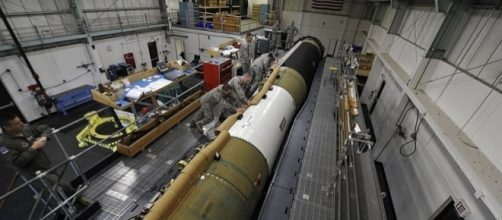The United States Air Force has successfully launched an unarmed Minuteman III missile from Vandenberg Air Force Base in California to strike a distant target. The main purpose of the exercise was to check accuracy and reliability of the ICBM weapon system, and the purpose was served when it crossed more than 4000 miles across the Pacific Ocean to hit the designated target in an atoll.
USAF has said that the test will provide useful data to ensure that a safe, secure and effective nuclear deterrent is available for deployment when the need arises.
Military chiefs have added that it was a pre-planned activity and was not to be treated as a reaction to nuclear programs of North Korea.
Comparisons between US and North Korean ICBMs
According to Daily Mail UK, the Minuteman III missile launched from the base in California is a bulky affair weighing nearly 80,000 pounds with a range of approximately 6,000 miles. The United States perceives this ICBM as an integral part of its strategic deterrent force. The latest launch was the fourth this year and is against the backdrop of the recent test carried out by North Korea when it launched its two-stage Hwasong-14 missile.
The Hwasong missile traveled 2,300 miles into space and returned to Earth but splashed into the sea coast near Hokkaido in Japan.
Experts of the US and South Korea have studied the videos of the missile’s trajectory. They have concluded that the video tends to suggest a failure of the missile because it was not robust enough to withstand the extreme heat and pressure that is created during re-entry into the Earth's atmosphere.
In the opinion of people in the know, this apparent failure would force North Korea to improve its performance. There are possibilities of increase in the number of tests on the Hwasong-14, and such tests could continue till it ensures that the warhead would survive reentry from space and strike its intended target.
What could come next?
North Korea tested the Hwasong-14 ICBM for the first time on July 4 and analysis of the flight data from Hwasong-14's second test gives an impression that its range could cover many areas and cities in the United States.
This is an area of concern because North Korea had, at one time, indicated Hawaii and Alaska as probable targets but, it can now reach larger cities and metros.
There are rumors that South Korea is contemplating a 'surgical strike' and missiles could be fired from F-15 fighters to destroy various nuclear facilities of the North provided President Moon Jae-in agrees to take such action. It may be recalled that, after taking over as president, he had expressed a desire to improve relations with the North and has now realized that such a situation is not likely to come. If the situation worsens, he might be called upon to take an unpleasant decision.


